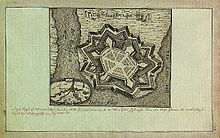Dünamünder Schanze
The Dünamünder Schanze or fortress Dünamünde dates from the 17th century and is located at the confluence of the Düna in the Baltic Sea eleven kilometers from the inland Riga old town . The outlines of the fortress and the moat are still visible today.
The fortress must not be confused with Dünamünde Castle , which was on the opposite side of the estuary. This was originally built as the Daugavgrīva Monastery in 1208 and taken over by the Teutonic Order in 1305 .
history
In 1561, during the Livonian War , today's district of Dünamünde became part of Poland-Lithuania . In the second half of the 16th century the river bed of the Daugava shifted five kilometers to the west. Thereupon the Poles built a new small jump near the new river mouth. In 1582 the new fortress was inspected by King Stephan Báthory . He renamed this fortress in Dünamünde. In August 1608 the fortress was conquered by the Swedes under Friedrich Joachim Mansfeld , who renamed it Neumünde. In the 1640s, a modern fortress with five bastions and two gates was built under the direction of the Swedish General Rothenburg . The stones from the ramparts of the old castle were used to rebuild the fortress. The ski jump was supposed to monitor the access to Riga on the Daugava. In the last quarter of the century, the fortress was modernized: a sixth bastion was built, new casemates and a powder cellar were added.

In 1695, Captain Heinrich Nicolaus Rüdinger became the commandant of the hill. Joachim Cronman succeeded him and died on March 5, 1703. In March 1700 the independent fortress Dünamünde was besieged by a Saxon army and stormed on March 13. The Swedish commander von Budberg, who defended the fortress with 500 men, capitulated after two days of resistance. The losses among the Saxons were high: 248 dead and 435 wounded. As a result, Riga was cut off from the supply to the Baltic Sea and could be besieged by the Saxons . The winners renamed the hill in honor of Augustus the Strong in Augustusburg. But shortly afterwards the Saxons withdrew again but left a garrison.
After the Battle of the Daugava in 1701, the hill was recaptured by the Swedish army after a brief siege. On August 10, 1710, the hill fell into Russian possession after another siege . The remaining 45 Swedes received free travel. The Russians rebuilt the fortress. 1742 were regent Anna Leopoldowna , her husband Anthon Ulrich and their son Ivan VI. imprisoned in Dünamünde. The fortress and its outbuildings were mobilized again during the First and Second World Wars .
Web links
Coordinates: 57 ° 2 ′ 42.4 " N , 24 ° 2 ′ 22" E

